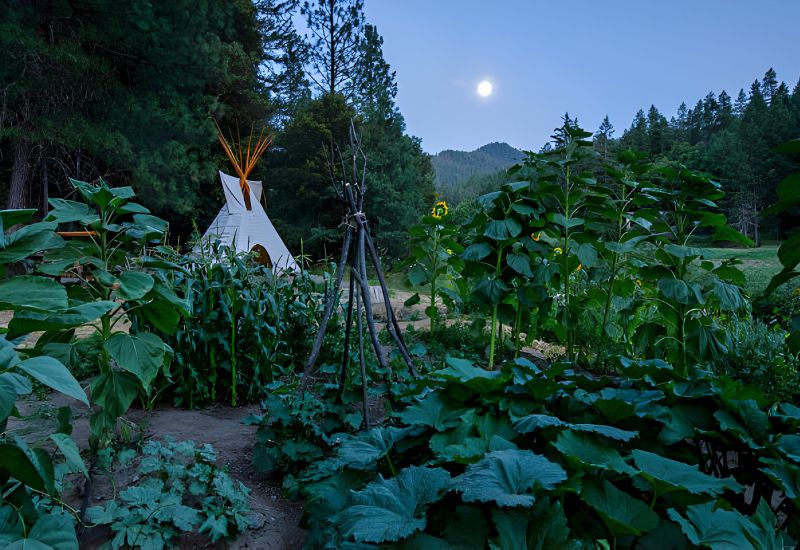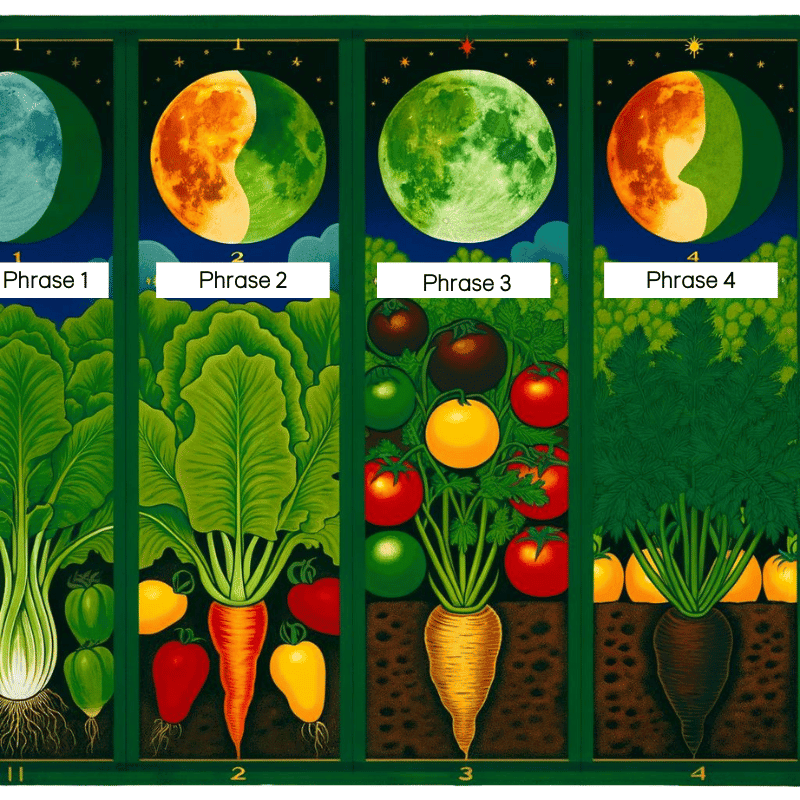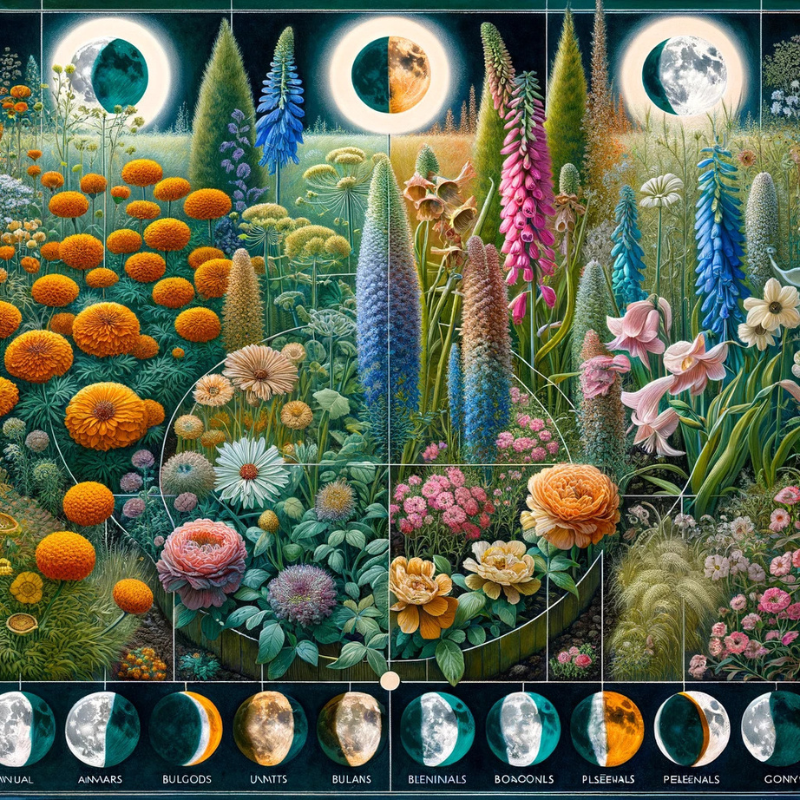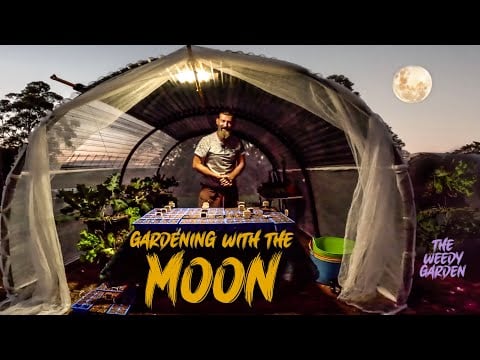
Let me let you in on a little secret from the past—our old calendars weren’t just for keeping track of days; they were a gardener’s best friend, moon phases and all. Why the moon, you ask? The Moon affects the germination of seeds, and everybody who worked the land knew it perfectly well, like my grandfather, and my father too.
Why not take a leaf out of their book? Tuning in to the moon’s cues isn’t just for the mystical or the ancient—it’s a simple hack that can spruce up your garden today. Bigger blooms, healthier plants—it’s all in the lunar timing. Let me show you how to harness lunar gardening principles for a healthier garden
The Moon Affects How Plants Germinate and Grow
The Moon cycle has 4 phases, and each is good for planting some types of vegetables. This has been tested, and it is actually true; it is not a “legend”, any studies prove it, including a straightforward project for the California State Science Fair by Brian C. Pearn entitled “Moonstruck: Are Plants Affected or Influenced by the Moon?”
You can try your own experiments, and I have seen many, and they all say the same thing: certain vegetables perform better when planted in a specific phase of the Moon.
Why and How Does the Moon Affect Plant Germination?
The answer is simple, and we see it all the time. Look at the tides of the sea; what causes them? It is the gravitation of the Moon! Yes, it pulls the water, but not just in the rivers and in the oceans, but also in the soil!
The sap inside the plants is also subject to the gravitational pull of the Moon, so, when it is strong, it goes up faster than when it’s weak. So, according to which phase you sow your vegetables, they will get more nutrients above ground, or below ground, to the roots.
What’s more, the light of the Moon has a “pull factor” on seeds, as does that of the Sun. So, put 2 and 2 together, and you will get an idea of why lunar phases can give you better and bigger crops. Or it will give you 4, just like the phases of the cycle of our satellite (or sister planet)…
Know the Phases of the Moon Cycle
The 4 phases of the Moon start from the New Moon and end with the next New Moon and they follow the gibbous, which is the bright part we see, the crescent (at some stages), the area that reflects the light of the Sun. And here they are.
- 1st phase, from New Moon to Half Moon.
- 2nd phase, from Half Moon to Full Moon.
- 3rd phase, from Full Moon to Half Moon.
- 4th phase, from Half Moon to New Moon.
By New Moon, we mean when it is fully dark, and by Full Moon, the three days around the actually fully lit silver disk in the sky. Each full cycle lasts 27 days, so it does not match the calendar months.
Also, phases 1 and 2 are called waxing Moon, while phases 3 and 4 go by the name of waning Moon.
This is all you need to know for now, because we can now go straight into which categories of veggies do best if planted in each phase.
Moon Phases and Which Veggies to Plant and Sow
So, straight to the practical side: which vegetables should you plant in each phase of the Moon?

· In the first phase, you should sow leaf vegetables, like lettuce, chard, spinach, kale, rhubarb etc.
· In the second phase, sow fruit vegetables, like tomatoes, peppers, pumpkins, zucchini, cucumbers etc.
· In the third phase, it’s good to plant root vegetables, like carrots, garlic, onions, potatoes, parsnips etc.
· In the fourth phase, you should rest, and stop sowing, because it is the least fertile time of the Moon cycle.
Overall, sow vegetables that produce overground with the waxing Moon, and those that give you underground crops with the waning Moon. Quite simple and effective. But there is more…
Moon Sowing in Your Ornamental Garden
Moon sowing and planting can also help you with the flowers in your decorative garden, and give you better blooms. Here is how to do it!

· With the waxing Moon, you should sow annual flowers, like zinnias, impatiens, sunflowers, snapdragons etc.
· With the waning Moon, sow bulbous plants, like daffodils, tulips, lilies etc., as well as biennial and perennial flowers, like violets, asters, hellebores etc. But avoid the last phase, remember…
Now you know which plants to sow in which phase, but how about transplanting?
When to Transplant Seedlings According to the Moon
Ask yourself a question, and you will get the answer yourself, “Where do I want the energy to go when I transplant my seedlings?” You don’t want them to grow straight away, you want them to establish themselves underground first, to develop their roots.
For this reason, you should transplant your seedlings in the Third Phase of the Moon. As we said, the waning phase is better for underground growth, but the Fourth Phase is the least fertile, so you are left with the third.
What Can You Do During the Fourth Phase of the Moon?
This doesn’t mean that during the Fourth Phase of the Moon you shouldn’t do any gardening at all; in fact, like all things natural, it has a purpose as well. This time is good for other chores of course, and when you are sowing and planting you can get a bit overwhelmed with the work to do, especially in spring.
But it is also ideal for some activities, like:
· Weeding
· Pruning
· Mowing your lawn, if you want to keep it short…
Full Moon and New Moon: Two Key Times in Gardening
What should you do in your garden in the days of Full and New Moon though? Ok, to start with, for gardening, these two periods are a bit longer than the official ones, and they last 5 days each, so, the actual day, plus 2 before and 2 after.
The Full Moon days are when the light and gravitational pull of our satellite are strongest, and germination is very fast indeed, and here opinions are divided. Some gardeners say that it’s the best time to sow decorative varieties you want a big effect from, but I lean on the other side… Growth can be spindly if you seed at this time, so I would avoid it.
On the other hand, the days before the Full Moon, are the ideal time to use liquid fertilizer, and why? As we said, your plants’ sap is running up faster, so, they will absorb it more quickly and they will send it straight to the leaves (flowers, fruits etc.)
Give it a few days to seep into the soil, though, so you get the best of the Moon’s gravitational pull.
Around the days of the New Moon, you should prepare for the fertile days ahead, so, it’s a good time to till (if you do), or feed the soil, compost it, etc. And remember all those jobs you left behind because you were busy sowing, especially in spring!
How to Use a Moon Calendar for Your Gardening Jobs
Now you know the basics of Moon sowing, planting and sowing, the best thing to do is to check its phases. Look at your calendar, do you see them there? As I said, they have disappeared from modern ones, because we moved from a farming world and economy, to an industrial and post-industrial one.
Otherwise, you can simply get the Moon phases online, like this one, and then copy them on your normal calendar.
And there is another choice for you; you can get a simple farming Moon calendar, like this one.
Note that it is the same for each cycle of the Moon, so you still need to know when the New Moon is etc.
And these phases don’t start at the same time all around the world! So, you must check the exact time when New Moons, Half Moons and Full Moons start in your area (country or region).
But once you get used to it, it becomes very simple indeed!
What Next?
Next, of course, you can start using the Moon phases and cycle for your sowing, transplanting, pruning etc. But I want to tickle your curiosity before I leave you…
The Moon also has ascending and descending phases, which are when it rises higher over the horizon, and then it goes down again. You must have noticed that sometimes it is really high up in the sky, and others it gets so low it almost touches the Earth…
Well, if you have liked this article, and you want to know more, and have more advanced Moon gardening skills, we could meet again soon, and I could tell you all you need to do in the ascending and descending phases to get the best results in your vegetable and decorative garden…

Written By
Adriano Bulla
After many years as an academic in London, Adriano Bulla became a writer, publishing books like A History of Gardening, Organic Gardening and Elements of Garden Design; he then decided to become a gardener, following his childhood dream, and has been following his dream writing and gardening professionally in Southern Europe, where he has specialized in new and innovative organic gardening fields and techniques, like permaculture, regenerative agriculture, food forests and hydroponics.

